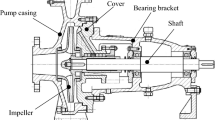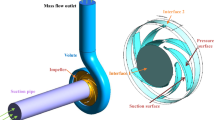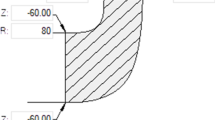Abstract
In this study, a numerical analysis was carried out to investigate the effects of blade thickness on hydraulic performance and cavitation phenomenon of a mixed-flow pump. The three-dimensional Reynolds-averaged Navier-Stokes equation, which was discretized using the finite volume method, was applied to solve a steady-state analysis. For cavitation analysis, the Rayleigh-Plesset equation was applied to calculate the transition between liquid and vapor phases. The hydraulic performance of a mixed-flow pump changes depending on the blade thickness and was systematically analyzed under various operating conditions. Blade thickness was defined as a blockage, and the cavitation coefficient was considered to express the suction performance. Cavitation characteristics were analyzed for each blockage in relation to the vapor volume fraction. The amount and pattern of vapor were different for each blade thickness case. Furthermore, in this paper, detailed flow analyses that consider the angle of incidence are presented and discussed. To verify the numerical analysis results, an experimental test was conducted at specific points.
Similar content being viewed by others
References
K. W. Cheah, T. S. Lee, S. H. Winoto and Z. M. Zhao, Numerical flow simulation in a centrifugal pump at design and off-design conditions, International Journal of Rotating Machinery (2007).
A. Sojoudi, A. Nourbakhsh and H. J. Shokouhmand, Experimental evaluation of temperature rise in centrifugal pumps at partial flow rates, Journal of the Brazilian Society of Mechanical Sciences and Engineering, 40 (2018) 183.
J. F. Gulich, Centrifugal Pumps, Springer, Berlin, Germany (2008).
A. J. Stepanoff, Centrifugal and Axial Flow Pumps, John Wiley & Sons, Inc., New York, USA (1957).
M. Teodor, Impeller Design using CAD Techniques and Conformal Mapping Method, Politehnica University of Timisoara, Romania (2012).
S. Kim, U. B. Jeong, K. Y. Lee, H. H. Kim, J. Y. Yoon and Y. S. Choi, Design optimization of mixed-flow pump impellers with various shaft diameters at the same specific speed, Journal of Mechanical Science and Technology, 32(3) (2018) 1171–1180.
M. G. Patel and A. V. Doshi, Effect of impeller blade exit angle on the performance of centrifugal pump, ISSN ISO 9001:2008 Certified Journal, 3(1) (2013) 2250–2459.
T. Shigemitsu, J. Fukutomi and K. Kaji, Influence of blade outlet angle and blade thickness on performance and internal flow conditions of mini centrifugal pump, International Journal of Fluid Machinery and Systems, 4(3) (2011) 317–323.
Y. X. Jin et al., A study on the effects of blade thickness on the performance of low specific speed centrifugal pump, Advanced Materials Research, 1070–1072 (2015) 1957–1962.
H. Chang, W. Li, W. Shi and J. Liu, Effect of blade profile with different thickness distribution on the pressure characteristics of novel self-priming pump, Journal of the Brazilian Society of Mechanical Sciences and Engineering, 40 (2018) 518.
Y. S. Choi, S. Kim, K. Y. Lee and J. H. Kim, Hydrodynamic design for mixed-flow pumps based on optimum design database, KSFM Winter Conference (2015) 95–96.
Y. I. Kim, S. Kim, H. M. Yang, K. Y. Lee, J. H. Kim and Y. S. Choi, A study on the effect of impeller leading edge blockage on the hydraulic performance of a mixed-flow pump, ISSN 2287-9706, The KSFM Journal of Fluid Machinery, 21(4) (2018) 11–16.
Y. I. Kim, S. Kim, H. M. Yang, K. Y. Lee, J. H. Kim and Y. S. Choi, A numerical study on suction performance of a mixed-flow pump with variation of impeller blade thickness, KSFM Summer Conference (2018) 157–158.
S. N. Lee, N. I. Tak and J. M. Noh, Heat transfer prediction in pipe flow by the wall function of SST turbulence model, KSCFE Conference (2013) 355–358.
Y. G. Lee, J. H. Yuk and M. H. Kang, Flow analysis of fluid machinery using CFX pressure-based coupled and various turbulence model, The KSFM Journal of Fluid Machinery, 7(5) (2004) 82–90.
Y. Fu, J. Yuan, S. Yuan, G. Pace, L. d’Agostino, P. Huang and X. Li, Numerical and experimental analysis of flow phenomena in a centrifugal pump operating under low flow rates, ASME Journal of Fluids Engineering, 137(1) (2014) 011102–12.
F. Tang and J. W. Li, Numerical simulation of rotating cavitation in a liquid hydrogen pump inducer, Proceedings of the 13th Asian Congress of Fluid Mechanics, Dhaka, Bangladesh (2010).
H. Ding, F. C. Visser, Y. Jiang and M. Furmanczyk, Demonstration and validation of a 3D CFD simulation tool predicting pump performance and cavitation for industrial applications, ASME Journal of Fluids Engineering, 133(1) (2011) 011101–14.
ANSI/HI 1.6, American National Standard for Centrifugal Pump Tests, Hydraulic Institute, Parsippany, NJ, USA (2000).
ISO 5198, Mixed-flow and Axial Pump Tests-Code for Hydraulic Performance Tests-Precision Class, International Organization for Standardization for Centrifugal (1987).
Y. I. Kim, S. Kim, H. M. Yang, K. Y. Lee, J. H. Kim and Y. S. Choi, Effect of blade thickness on hydraulic performance of a mixed-flow pump impeller, IOP Conference Series: Earth and Environmental Science, 240(032035) (2019).
W. Zhang, Z. Yu and B. Zhu, Influence of tip clearance on pressure fluctuation in low specific speed mixed-flow pump passage, Energies, 10(2) (2017) 148.
H. Bing, S. Cao, C. He and L. Lu, Experimental study of the effect of blade tip clearance and blade angle error on the performance of mixed-flow pump, Science China Technological Sciences, 56(2) (2013) 293–298.
Acknowledgments
This research was supported by a grant of ‘Development of Design Technology for Thermal Energy Devices with Industrial Demand (kitech JA-19-0011)’ from the Korea Institute of Industrial Technology (KITECH).
Author information
Authors and Affiliations
Corresponding author
Additional information
Recommended by Associate Editor Weon Gyu Shin
Yong-In Kim received his B.S. degree from Chungnam National University, Korea, in 2016. Since March 2017, as a student researcher, he is pursuing his integrated course in turbomachinery from the Korea Institute of Industrial Technology (KITECH) campus of University of Science & Technology (UST). His research interests include computational fluid dynamics, design optimization, and experimental tests.
Sung Kim received his B.S. degree from from the Korea University of Technology and Education (KOREA TECH) in 2006, and his M.S. and Ph.D. in mechanical engineering from the Hanyang University in 2009 and 2019, respectively. He is currently a researcher in the Korea Institute of Industrial Technology (KITECH). His research interests are turbomachinery design, numerical analyses, optimization techniques, and experimental tests.
Hyeon-Mo Yang received his B.S. and M.S. degrees from the Korea University of Technology and Education (KOREA TECH), Korea, in 2005 and 2013, respectively. Currently, he is a researcher in the Korea Institute of Industrial Technology (KITECH). His research interests include turbomachinery design, numerical analyses, and experimental tests.
Kyoung-Yong Lee received his B.S. degree from Korea University of Technology and Education (KOREA TECH), Korea, in 2002 and his M.S. and Ph.D. in Mechanical Engineering from the same university in 2004 and 2017, respectively. He has been a Senior Researcher in the Thermal & Fluid System R&D Group, at KITECH, Korea. His research interests include turbomachinery design, numerical analyses, system loss analyses, and experimental tests.
Young-Seok Choi received his B.S. degree from Seoul National University in 1988, and his M.S. and Ph.D. in mechanical engineering from the same university in 1990 and 1996, respectively. He is currently a Principal Researcher at Korea Institute of Industrial Technology (KITECH) and a Professor at University of Science and Technology (UST). His research interests include computational fluid dynamics and design optimization of turbomachinery.
Rights and permissions
About this article
Cite this article
Kim, YI., Kim, S., Yang, HM. et al. Analysis of internal flow and cavitation characteristics for a mixed-flow pump with various blade thickness effects. J Mech Sci Technol 33, 3333–3344 (2019). https://doi.org/10.1007/s12206-019-0628-z
Received:
Revised:
Accepted:
Published:
Issue Date:
DOI: https://doi.org/10.1007/s12206-019-0628-z




